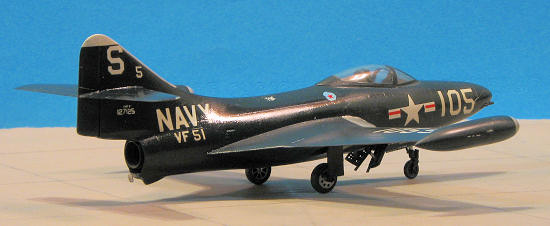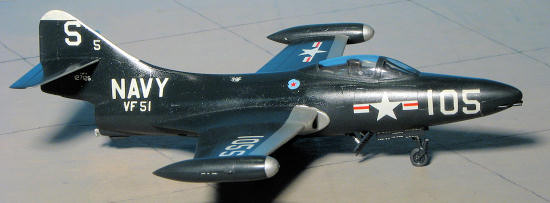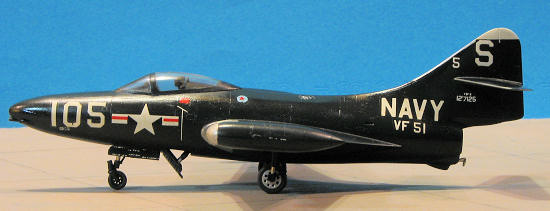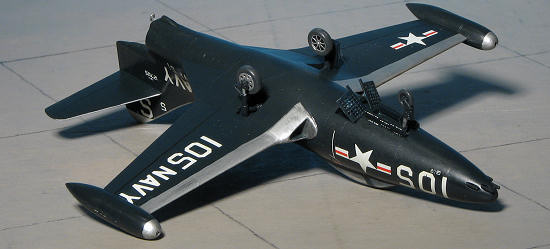
Hasegawa 1/72 F9F-2 Panther
| KIT #: | 1182 |
| PRICE: | $3.75 or so at the time |
| DECALS: | One or two options |
| REVIEWER: | Scott Van Aken |
| NOTES: | Kit built in the mid 1980s. |

| HISTORY |
The Grumman F9F Panther was the manufacturer's first jet fighter and one of the U.S. Navy's first successful carrier-based jet fighters. The Panther was the most widely used U.S. Navy jet fighter of the Korean War, flying 78,000 sorties and scoring the first air-to-air kill by the US Navy in the war, the downing of a North Korean Yakovlev Yak-9 fighter. Total F9F production was 1,382, with several variants being exported to Argentina.
 F9F-2s, F9F-3s and F9F-5s served with distinction in the Korean War, mainly as attack aircraft, showing noticeable resistance to a.a. fire; despite their relative slow speed, they also managed in downing two Yak-9s and five Mikoyan-Gurevich MiG-15s with a loss of only one F9F. On 3 July 1950, Lieutenant, junior grade Leonard H. Plog of U.S. Navy's VF-51 flying an F9F-3 scored the first air victory of the war by shooting down a Yak-9. The first MiG-15 downed was on 9 November 1950 by U.S. Navy Lieutenant Commander William (Bill) Amen of VF-111 "Sundowners" Squadron flying an F9F-2B. Two more were downed on 18 November 1950, and the other two were downed on the 18 November 1952. The type was the primary Navy and USMC jet fighter and ground-attack aircraft in the Korean conflict. Astronaut Neil Armstrong flew the F9F extensively during the war, even ejecting from one of the aircraft when it was brought down by a wire strung across a valley. Another astronaut, John Glenn and Boston Red Sox All Star Ted Williams as Marine Corps pilots, also flew the F9F
F9F-2s, F9F-3s and F9F-5s served with distinction in the Korean War, mainly as attack aircraft, showing noticeable resistance to a.a. fire; despite their relative slow speed, they also managed in downing two Yak-9s and five Mikoyan-Gurevich MiG-15s with a loss of only one F9F. On 3 July 1950, Lieutenant, junior grade Leonard H. Plog of U.S. Navy's VF-51 flying an F9F-3 scored the first air victory of the war by shooting down a Yak-9. The first MiG-15 downed was on 9 November 1950 by U.S. Navy Lieutenant Commander William (Bill) Amen of VF-111 "Sundowners" Squadron flying an F9F-2B. Two more were downed on 18 November 1950, and the other two were downed on the 18 November 1952. The type was the primary Navy and USMC jet fighter and ground-attack aircraft in the Korean conflict. Astronaut Neil Armstrong flew the F9F extensively during the war, even ejecting from one of the aircraft when it was brought down by a wire strung across a valley. Another astronaut, John Glenn and Boston Red Sox All Star Ted Williams as Marine Corps pilots, also flew the F9F
Panthers were withdrawn from front-line service in 1956, but remained in training roles and with Reserve units until 1958, some continuing to serve in small numbers into the 1960s.
| THE KIT |
 This is one of Hasegawa's second generation kits. Gone was the super thick plastic and nearly non-existent cockpit for the earlier kits. Also gone was the rather poor fit that these kits had. This time, the kit was fully up to modern standards of the time with crisp detailing, a nice cockpit and a properly thin, though single piece, canopy. These kits are also 'pre-insert' in that you have practically no inserts.
This is one of Hasegawa's second generation kits. Gone was the super thick plastic and nearly non-existent cockpit for the earlier kits. Also gone was the rather poor fit that these kits had. This time, the kit was fully up to modern standards of the time with crisp detailing, a nice cockpit and a properly thin, though single piece, canopy. These kits are also 'pre-insert' in that you have practically no inserts.
The Panther is a pretty good kit all around and has still not been eclipsed in this scale. I have to confess that it has been well nigh 25 years since I built this one, so I can't recall how many sprues there were, but I can tell you that I needed to put weight in it. I also can't recall the markings option as this Minicraft reboxing used the Hasegawa decals, though it was in a US box with translated instructions.
| CONSTRUCTION |
To say that these kits are pretty good builds would be a bit of an understatement. I built a lot of these types of kits and found that the fit was, for the most part, excellent. About the only pla ce I needed to pay attention was the wing root intakes. The lower wings are one piece that includes the wing tank half and assembly is a snap. Same for the somewhat basic cockpit that, like Hasegawa kits of today, rely on decals for the instrument panel and side consoles. There is a fair bang seat and a control stick to finish things off. The interior is basically black so painting is quite easy.
ce I needed to pay attention was the wing root intakes. The lower wings are one piece that includes the wing tank half and assembly is a snap. Same for the somewhat basic cockpit that, like Hasegawa kits of today, rely on decals for the instrument panel and side consoles. There is a fair bang seat and a control stick to finish things off. The interior is basically black so painting is quite easy.
Getting the airframe together was easy enough, with minimal filler, though one should not forget to put a bit of weight in the nose on this one. After attaching the tail planes and the wing, a bit of filler was needed on the wing to fuselage join. I then glued on the landing gear, attached the canopy, masked it and got ready to paint.
| COLORS & MARKINGS |
 Korean War Navy planes are one of my favorites to paint. They are basically overall sea blue and that includes the wheels, landing gear and inside of the wheel wells. For this one, I used Testors Model Master enamels. I did not use the kit decals aside from data markings and insignia, instead choosing to use various Microscale/Superscale letter/number sets to duplicate the aircraft of Lt(jg) Leonard H. Plog's Yak-killing F9F-3. You haven't lived until you have done the tiny individual letters/numbers for the type and serial data set. Once all the info on markings was found (I believe it was a Squadron 'In Action' book that provided this), I found something sort of like a VF-51 unit badge (actually a blue background with a star in it) to stick on. Typical of Microscale sheets of the day, the insignia are off register and the small lettering is illegible. Funny how we all thought these were the best back then. Now they are mediocre.
Korean War Navy planes are one of my favorites to paint. They are basically overall sea blue and that includes the wheels, landing gear and inside of the wheel wells. For this one, I used Testors Model Master enamels. I did not use the kit decals aside from data markings and insignia, instead choosing to use various Microscale/Superscale letter/number sets to duplicate the aircraft of Lt(jg) Leonard H. Plog's Yak-killing F9F-3. You haven't lived until you have done the tiny individual letters/numbers for the type and serial data set. Once all the info on markings was found (I believe it was a Squadron 'In Action' book that provided this), I found something sort of like a VF-51 unit badge (actually a blue background with a star in it) to stick on. Typical of Microscale sheets of the day, the insignia are off register and the small lettering is illegible. Funny how we all thought these were the best back then. Now they are mediocre.
| FINAL CONSTRUCTION |
 The last things were to install the wheels and gear doors and do some hand painting. I used a silver paint pen to do the silver bits on the leading edges. For the time, they looked fine. Now they look like they need redone. I believe the kit came with rockets that I chose not to use.
The last things were to install the wheels and gear doors and do some hand painting. I used a silver paint pen to do the silver bits on the leading edges. For the time, they looked fine. Now they look like they need redone. I believe the kit came with rockets that I chose not to use.
Over the years, this model has moved pretty much around the world. As such, it has held up well, but when I went to grab it from the shelf for photographing, I noticed there were many scuff marks in the clear coat. I pulled out the Future and gave it another coat, which made all those nasty scuff disappear. I also broke off the nose gear (probably for the umpteenth time). I did the drill and paper clip section thing to it and it is now probably better than new.
| CONCLUSIONS |
Hasegawa doesn't re-issue this one often enough for most of us. I know that when they do, it is well worth seeking out.
| REFERENCES |
http://en.wikipedia.org/wiki/F9F-2_Panther
July 2010
Copyright ModelingMadness.com. All rights reserved. No reproduction in part or in whole without express permission from the editor.
If you would like your product reviewed fairly and fairly quickly, please contact the editor or see other details in the Note to Contributors.